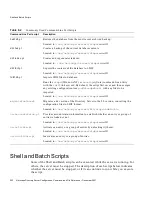
Shell and Batch Scripts
Chapter
8
Command-Line Scripts
227
For more information on the different storage schemes such as
SSHA
,
SHA
,
CRYPT
and
CLEAR
see the Netscape Directory Server Administrator’s Guide.
ldif2db (Import)
Runs the
slapd
(Windows NT) or
ns-slapd
(Unix) command-line utility with the
ldif2db
keyword. To run this script the server must be stopped.
For information on the equivalent Perl script, refer to “ldif2db.pl (Import),” on
page 237.
Syntax
Options
NOTE
Note that
ldif2db
supports LDIF version 1 specifications. You can
load an attribute using the
:<
URL specifier notation, for example:
j
pegphoto:< file:///tmp/myphoto.jpg
Although the official notation requires three
///
, the use of one
/
is
tolerated. For further information on the LDIF format see Chapter
4, “Managing Directory Entries” in the Netscape Directory Server
Administrator’s Guide.
Shell script (UNIX)
ldif2db -n backend_instance | {-s includesuffix}* [{-x excludesuffix}*]
{-i ldiffile}* [-O] [-g string] [-G namespace_id]
Batch file (NT)
ldif2db -n backend_instance | {-s includesuffix}* [{-x excludesuffix}*]
{-i ldiffile}* [-O] [-g string] [-G namespace_id]
-n
Instance to be imported. Ensure that you specify an instance that
corresponds to the suffix contained by the LDIF file because otherwise
the data contained by the database is deleted and the import fails.
-i
File name of the input ldif file(s). When you import multiple files, they
are imported in the order in which you specify them on the command
line.
-s
Suffix(es) to be included or to specify the subtree(s) to be included if -n
has been used.
















































